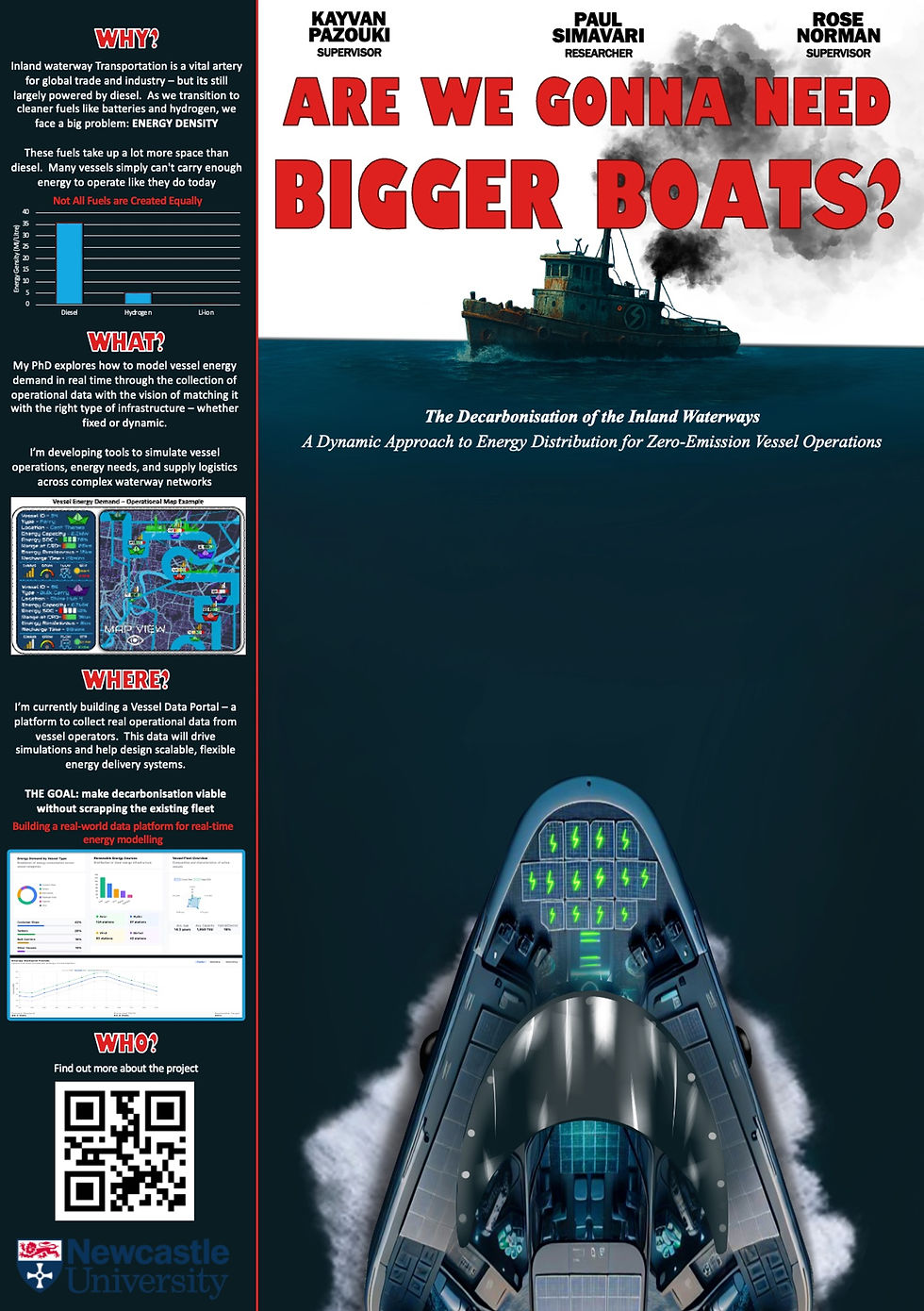Zero Emission Inland Waterways


The research began with a comprehensive review of existing literature on IWW operations, decarbonisation strategies, and energy infrastructure. This helped identify key challenges, particularly the gap between propulsion innovation and the logistics of energy delivery. It also revealed the limite work focused on vessel-level energy demand within real operational contexts.

A data strategy will be designed to support the collection of vessel-specific operational data from real-world users. This includes the development of a web-based portal that enables operators to anonymously submit key trip and vessel information. The data will underpin modelling and scenario testing, helping to ensure solutions are grounded in real conditions.

Using the collected and inferred data, simulation tools will model the energy demand profiles of inland vessels under various operating conditions. This includes different vessel types, duty cycles, cargo loads, and fuel options. The model will form the basis for testing infrastructure deployment strategies across networks.

The final phase involves validating the energy delivery model using simulated real-world scenarios and refining the proposed system architecture. This will include evaluating combinations of shore-based and mobile infrastructure, and generating a strategic roadmap for implementation — one that supports a gradual and practical transition for the IWT sector.
My Poster as Presented at the MTPC

The Original Jaws Poster (Roger Kastel)

Data Access and Participation

Data Standardisation and Integration

Validation of Models and Simulations

Scalability and Regional Variations

Translating to Viable Sector Solutions



The Decarbonisation of Europes Inland Waterways
Thank you for coming to look at my research.
I'm a Class One Marine Engineer with over 20 years experience across maritime and related engineering sectors. I'm now using that experience as a PhD Researcher at Newcastle University to help understand the challenges in the decarbonisation of the inland waterways. My focus is specifically on the energy demand of vessels across multiple contexts with a view to understanding the demands of energy deployment for zero-emission operations.
Hi, I'm Paul

Research Abstract
The inland waterway transport sector faces urgent decarbonisation pressures, however most vessels still rely on diesel due to operational flexibility, fuel density, and infrastructure limitations. Emerging clean fuels such as batteries and hydrogen offer lower emissions, but their lower energy densities make them impractical for many vessels without significant design compromises or range limitations.
This research will argue that the core challenge is not propulsion or power management technologies, nor is it vessel optimisation or vessel design, though both these elements will play a critical role in achieving zero emission operations. The core challenge is energy logistics.
My PhD work will investigate how real-time vessel data can be used to predict energy demand across diverse operational profiles, and how this data can inform a flexible, scalable energy delivery system. By combining fixed and mobile infrastructure, the project seeks to unlock a just and viable transition for inland waterways without relying on fleet-wide vessel replacement.
My research poster was a little 'tongue in cheek' but I'm pleased it brought you this far! However, rather than designing bigger boats to carry more energy, this work explores how we build smarter systems to supply it — when and where it’s needed.

Research Context
Inland waterway transport plays a crucial but often overlooked role in national and international logistics. While efforts to decarbonise transport intensify, IWT remains locked into fossil fuel dependence, largely due to its unique operational characteristics and infrastructure gaps. This research will address the disconnect between vessel energy demand and the current energy supply landscape, a gap that threatens to stall progress toward net-zero goals for the sector.

IWT provides a low-emission, high-capacity alternative to road and rail, carrying large volumes of freight through urban centres and across national borders. In Europe alone, over 900 million tonnes of cargo are moved annually by water. For many regions, inland waterways are not supplementary — they are foundational to resilient logistics and decarbonisation strategies. This makes them a highly valuable backbone of global logistics.
Essential Backbone

Fossil Fuel Dependence
Despite growing awareness of climate targets, more than 98% of inland waterway vessels still rely on diesel engines. This is driven by fuel availability, vessel design, and a lack of viable alternatives that meet operational needs. Retrofits are limited, and new builds are costly with some vessels, like passenger ferries, costing 3-5 times what they would have cost — leaving operators with few realistic options for transition under current conditions.

Infrastructure Gap
Shore-based charging infrastructure is often limited to major ports or fixed locations, while inland vessels operate across dynamic routes with unpredictable duty cycles. As a result, energy demand frequently occurs far from where infrastructure exists — making fixed supply strategies mismatched with the real-world needs of the fleet. The decision of where to mount fixed infrastructure is complex and will leave many stranded or under supported in the switch.
Aim & Objectives
The aim of this research is to develop a viable, scalable solution for the decarbonisation of commercial IWW vessels involved in the transportation of commodities and passengers, focusing on delivering renewable or alternative sustainable energy along operational routes, to support IWW vessels and their continuous zero-emission operations.
Objective 1, Evaluate Energy Demand and Operational Profiles
To conduct a detailed analysis of energy demand in commercial IWW vessels across European IWW’s, including duty cycles, vessel typologies, load factors, propulsion systems, and environmental conditions (e.g., tide, temperature, current). This analysis will inform vessel classification and energy profiling frameworks that enable system-wide energy efficiency optimisation.
Objective 2, Analyse Vessel Routes and Locations
Investigate patterns in IWW operations across case study rivers (Thames, Danube, Rhine), identifying variations in route characteristics (urban vs. rural, passenger vs. freight) and infrastructure readiness.
Objective 3, Predict Energy Demand
To develop predictive energy demand models based on real-world data collected via a vessel data portal, enabling the simulation of energy needs under diverse operational scenarios. These models will support real-time energy forecasting and lay the groundwork for infrastructure simulation and optimisation.
Objective 4, Explore Alternative Fuels and Energy Solutions
Assess the feasibility and lifecycle impacts of future fuels, including battery-electric, hydrogen, ammonia, and methanol, within inland waterway contexts specifically when applied to vessel models.
Objective 5, Asses the Feasibility of On-Route Energy Supply
Evaluate the operational and economic feasibility of dynamic, on-route energy supply systems, including multiple infrastructure strategies for different vessel types and operations.
Objective 6, Optimise Energy Supply Chain and Charging Systems
To model and optimise potential energy delivery networks using the outputs of Objectives 1–5. This includes evaluating cost, reliability, spatial coverage, and environmental impact of energy delivery configurations, within inland waterway environments.
Objective 7, Develop a Viable Decarbonisation Solution for IWW
To integrate all prior findings into a systems-based, operationally flexible framework for decarbonising IWW transport. This framework should support stakeholder decision-making and be designed to inform both policy and practice. It should include technical simulations, practical deployment pathways, and contextual recommendations for implementation.
Methodology Overview
This research follows a structured, multi-phase approach that combines literature review, data strategy development, simulation modelling, and scenario testing. The goal is to understand how energy demand varies across inland waterway operations and how flexible infrastructure can meet that demand in practice.
The diagram below outlines the key high-level stages of the methodology and the basic progress. A more detailed technical framework has been developed as part of the project but is not shown here for brevity.
Key Challenges
Completing this PhD will require the overcoming of several major challenges that are intersected across data quality, system complexity, and real-world applicability. From accessing diverse and reliable vessel data, to validating model outputs across varying operational contexts, each challenge shapes the path towards building a scalable, industry-ready solution. Identifying and addressing these challenges is not only essential for academic rigour but for ensuring the research delivers real impact for inland waterway decarbonisation.
Literature Review - Abstract
My literature review sets out to understand why the inland waterway transport (IWT) sector, despite being one of the most energy-efficient freight options available, remains stubbornly reliant on fossil fuels and is failing to transition at pace to zero-emission operations. Focusing primarily on the Thames, Danube and the Rhine, the review critically evaluates existing strategies, technologies, policies and infrastructure through a practical, industry-informed lens. While electric propulsion systems and future fuels such as hydrogen and methanol have received growing attention (Buitendijk, 2023; Maersk, 2023), the literature reveals persistent weaknesses in infrastructure planning, fragmented policy frameworks, and a widespread lack of real-world data, particularly on vessel-level energy demand and operational profiles (Kenc and Szostak, 2022; Olmer et al., 2017).
Across all case studies and sections, the same pattern emerges: clean propulsion technology is not the main problem, it’s the lack of a scalable, adaptable energy delivery systems needed to meet the diverse and often unpredictable needs of IWT operations. Shore-based infrastructure remains patchy, inflexible, and largely incapable of supporting dynamic vessel movements across complex inland routes (CCNR, 2023; Electric Review, 2023). Despite major initiatives like NAIADES III, there is still no coherent strategy for how clean energy is supposed to reach vessels in real-time along their routes. The sector is effectively being asked to decarbonise without the means to do so.
The review identifies several research gaps in comparative studies across the inland waterway sector and more broadly in short sea shipping and maritime in general. The gaps are most obvious in performance data from early adopter vessels, lifecycle assessments of emerging solutions, and the digital tools needed to simulate operational demand (Foretich et al., 2021; Zero Emission Services, 2025a). It concludes that any serious attempt to decarbonise IWT must start with understanding energy demand, what vessels need, when they need it, and where they need is, and it must focus on building the systems that deliver it. Without that, zero-emission navigation will remain an ambition rather than an outcome. The outcome of my literature review positions the need for a dynamic energy delivery framework not as a convenience, but as a prerequisite for decarbonising the sector in a way that is viable, scalable, and grounded in the real-world.
Would you like to find out more about the Literature Review?
Story Behind the Poster
If you were at the MarRI-UK Marine Technology Postgraduate Conference (MTPC) then you might have seen my 'academic' poster. I know it doesn’t look like your typical academic poster. That’s the point. It was inspired by the iconic Jaws movie poster, I wanted to do something unexpected, something bold, recognisable, and, at least water-related (You wouldn't believe the number of ideas I had to start with!! Probably the next best ideas were Back to the Future and The Matrix, but I figured that giant sharks were more universally understood, and I could construe, if somewhat distant, a connection with the inland waterways). I believe the goal with academic poster events like the one at MPTC isn’t just to showcase research, it’s to spark curiosity and drive engagement.
My project relies on the inland waterway community to share vessel data that will feed into the models that I will be building. Its my hop that the data will shape real-world solutions for decarbonisation. So if you’re part of the IWW sector, or know someone who is, please share this project website, have a look around, and get involved - My project can only be successful with the engagement of the IWW community. The poster may be a different style, but the challenge is very real.




